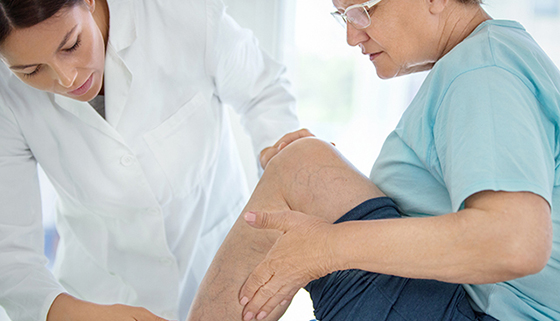Vascular Conditions & Treatments Danville
Also known as the circulatory system, the vascular system is the collection of organs responsible for moving blood throughout the body. This includes the heart, lungs, and miles of arteries and veins/blood vessels.
A vascular condition is when part of this process isn’t functioning properly, affecting blood flow. Let’s discuss some of the most common vascular conditions, including their symptoms and standard treatments.
Aortic Aneurysm
Smoking, high blood pressure, trauma, or other health factors can cause an aneurysm, or bulge in the artery wall. When this occurs in the aorta (the large blood vessel looping down from the heart and continuing down the torso), it is known as an aortic aneurysm. Thoracic aortic aneurysms happen in the chest, while abdominal aortic aneurysms occur in the lower section of the aorta.
The symptoms of an aortic aneurysm can include pulsing or pain in the abdominal region or back. If this pain is extreme or if you’re experiencing a fast pulse, dizziness, or sweating, you could have a ruptured aneurysm and should call 911. Non-ruptured aortic aneurysms can be treated with medication, beta-blockers, calcium channel blockers, or surgery.
Aortic Dissection
An aortic dissection is when there is a tear in the inner layer of the aorta, causing a weak point. This could be caused by hypertension, pregnancy, trauma, or disease. Patients may notice chest pain, shortness of breath, fainting, or nausea. Surgery with a stent or graft is usually the best course of action.
Carotid Artery Disease
Carotid artery disease describes plaque build-up in the arteries that carry blood from the heart to the brain. In addition to a stroke or mini stroke, this disease can present as slurring of speech, loss of vision in one eye, or numbness on one side of the body. Treatment is typically an endarterectomy to remove the plaque or angioplasty with stent placement.
Mesenteric Ischemia
When a blood clot or atherosclerosis causes a decrease in oxygenated blood to the stomach and intestines, the condition is called mesenteric ischemia. The blocked section of artery needs to be surgically altered or removed.
Peripheral Artery Disease (PAD)
PAD describes when there is a plaque buildup in the arteries of the limbs. Since this often happens in the legs or feet, symptoms can include pain or cramping when walking. Additionally, patients might notice a change in skin texture, hair loss, or erectile dysfunction. PAD treatment typically involves adopting a healthier lifestyle, medication, or surgery.
Thoracic Outlet Syndrome
Trauma or a recurring injury to the space between the collarbone and ribs can sometimes result in the compression of the underlying blood vessels and nerves, known as thoracic outlet syndrome (TOS). Your doctor may recommend physical therapy, medication, or surgery for more serious cases.
Venous Disease/Venous Insufficiency
Venous disease is when the valves in your blood vessels malfunction, causing blood to flow in the wrong direction. This can result in skin ulcers, blood clots, spider veins, and varicose veins. Depending on your symptoms, we may suggest compression stockings or possibly surgical removal.
Courteous, patient and caring
“This was my first visit with Dr Gottlieb. He spent a long time with me going over my past records, took me through my CT scans slide by slide, went over my diet, and thoroughly explained my condition and options to me. I have never been to a physician so courteous, patient and caring. I strongly recommend Dr. Gottlieb to anyone. He was simply fantastic.”
READ MORE REVIEWS
Your Vascular Treatment Consultation
While we’ve hopefully helped you gain a better understanding of common vascular conditions, your symptoms must be diagnosed and treated by a board-certified cardiologist. At East Bay Cardiovascular and Thoracic Associates, our extensive team of providers is well-suited to help at one of our five convenient locations in the East Bay, California area.
During your initial consultation, your doctor will carefully listen to your concerns and examine your medical history, as well as study any information from your primary care provider (if applicable). To better diagnose your condition and more accurately determine your customized treatment plan, he or she might order one or more of the following diagnostic tests:
- Ultrasound
- Doppler ultrasound
- Intravascular ultrasound (IVUS)
- Angiography
- CT angiography (CTA)
- Magnetic resonance angiography (MRA)
- Ankle-brachial index (ABI)
- Venography

Contact Us for More Details
If you think you are experiencing any of the symptoms related to these vascular conditions and treatments in Danville, our providers at East Bay Cardiovascular and Thoracic Associates are here to help. Contact us today to schedule your consultation.
Related Links


